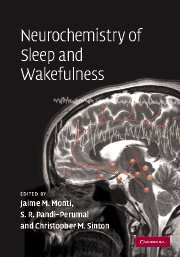Book contents
- Frontmatter
- Contents
- List of contributors
- Preface
- Acknowledgements
- Abbreviations
- I The neurochemistry of the states of sleep and wakefulness
- II The influence of neurotransmitters on sleep and wakefulness
- III Changing perspectives
- 10 Melatonin and its receptors: biological function in circadian sleep–wake regulation
- 11 Sleep regulatory factors
- 12 Adenosine and sleep–wake regulation
- 13 Prostaglandins and the regulation of sleep and wakefulness
- 14 Neuropeptides and sleep–wake regulation
- 15 Orexins in sleep and wakefulness: rodent models of narcolepsy–cataplexy
- 16 The relevance of experimental pharmacology to currently available sleep–wake therapeutics
- Index
- Plate section
10 - Melatonin and its receptors: biological function in circadian sleep–wake regulation
from III - Changing perspectives
Published online by Cambridge University Press: 23 October 2009
- Frontmatter
- Contents
- List of contributors
- Preface
- Acknowledgements
- Abbreviations
- I The neurochemistry of the states of sleep and wakefulness
- II The influence of neurotransmitters on sleep and wakefulness
- III Changing perspectives
- 10 Melatonin and its receptors: biological function in circadian sleep–wake regulation
- 11 Sleep regulatory factors
- 12 Adenosine and sleep–wake regulation
- 13 Prostaglandins and the regulation of sleep and wakefulness
- 14 Neuropeptides and sleep–wake regulation
- 15 Orexins in sleep and wakefulness: rodent models of narcolepsy–cataplexy
- 16 The relevance of experimental pharmacology to currently available sleep–wake therapeutics
- Index
- Plate section
Summary
Biosynthesis and metabolism of melatonin
Melatonin was isolated in 1958 by Lerner and his associates, its chemical nature being identified as N-acetyl-5-methoxytryptamine (Lerner et al. 1958, 1959) (Fig. 10.1). In vertebrates, melatonin is primarily secreted by the pineal gland. Synthesis also occurs in other cells and organs including the retina (Cardinali and Rosner 1971; Tosini and Menaker 1998; Liu et al. 2004), human and murine bone marrow cells (Conti et al. 2000), platelets (Champier et al. 1997), gastrointestinal tract (Bubenik 2002), skin (Slominski et al. 2005a,b), or lymphocytes (Carrillo-Vico et al. 2004). However, circulating melatonin is derived only from the pineal gland, as shown by its disappearance after pineal removal. Since there is no storage of melatonin in the pineal gland, and since the circulating melatonin is degraded rapidly by the liver, plasma levels of melatonin reflect pineal biosynthetic activity.
Melatonin secretion is synchronized to the light/dark (LD) cycle, with a nocturnal maximum (in young humans, about 200 pg/ml plasma) and low diurnal baseline levels (about 10 pg/ml plasma). Studies have supported the value of the exogenous administration of melatonin in circadian rhythm sleep disorders, insomnia, cancer, neurodegenerative diseases, disorders of the immune function, and oxidative damage (Karasek et al. 2002; Pandi-Perumal et al. 2005, 2006; Srinivasan et al. 2005a,b, 2006; Hardeland et al. 2006).
- Type
- Chapter
- Information
- Neurochemistry of Sleep and Wakefulness , pp. 283 - 314Publisher: Cambridge University PressPrint publication year: 2008
- 6
- Cited by



